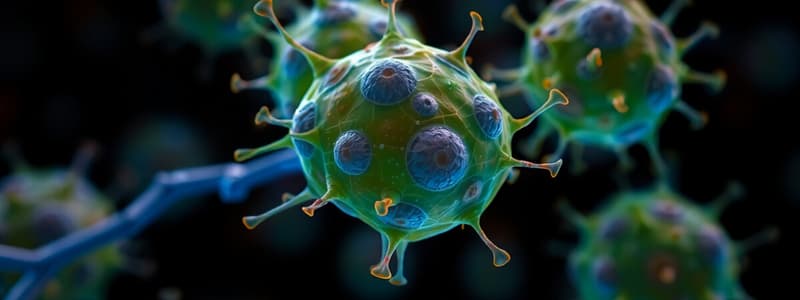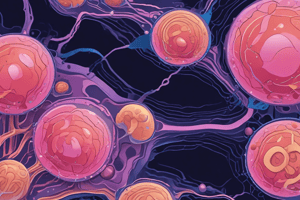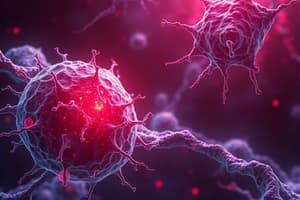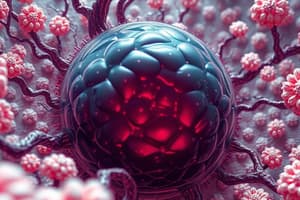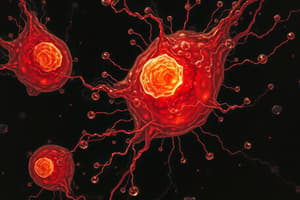Podcast
Questions and Answers
Which of the following mechanisms allows cancer cells to invade local tissues during metastasis?
Which of the following mechanisms allows cancer cells to invade local tissues during metastasis?
- Secretion of growth factors that inhibit angiogenesis.
- Increased expression of integrins to reduce cell migration.
- Upregulation of E-cadherin, promoting strong cell-cell adhesion.
- Breakdown of the extracellular matrix (ECM) by matrix metalloproteinases (MMPs). (correct)
Which process describes the ability of cancer cells to exit the bloodstream and invade distant tissues?
Which process describes the ability of cancer cells to exit the bloodstream and invade distant tissues?
- Local Invasion
- Circulation
- Extravasation (correct)
- Intravasation
Which of the following is a critical function of circulating tumor cells (CTCs) in the metastatic process?
Which of the following is a critical function of circulating tumor cells (CTCs) in the metastatic process?
- Secreting growth factors that promote differentiation of cancer cells into benign phenotypes.
- Acting as a key indicator of metastasis, representing cells that have detached from the primary tumor. (correct)
- Facilitating the repair of damaged blood vessels, preventing cancer cell dissemination.
- Enhancing immune surveillance by attracting immune cells to the primary tumor site.
What role do tumor-associated macrophages (TAMs) play in angiogenesis during metastasis?
What role do tumor-associated macrophages (TAMs) play in angiogenesis during metastasis?
How does the loss of tumor suppressor genes such as p53 and RB1 contribute to metastasis?
How does the loss of tumor suppressor genes such as p53 and RB1 contribute to metastasis?
What is the role of DNA methylation in the context of cancer metastasis?
What is the role of DNA methylation in the context of cancer metastasis?
How does epithelial-to-mesenchymal transition (EMT) contribute to the metastatic process?
How does epithelial-to-mesenchymal transition (EMT) contribute to the metastatic process?
Which of the following mechanisms is involved in pre-conditioning the metastatic site to create a favorable environment for metastatic cell growth?
Which of the following mechanisms is involved in pre-conditioning the metastatic site to create a favorable environment for metastatic cell growth?
How does targeting tumor angiogenesis with VEGF inhibitors like Bevacizumab help in therapeutic intervention?
How does targeting tumor angiogenesis with VEGF inhibitors like Bevacizumab help in therapeutic intervention?
What is the clinical relevance of detecting circulating tumor cells (CTCs) in the bloodstream?
What is the clinical relevance of detecting circulating tumor cells (CTCs) in the bloodstream?
Flashcards
Metastasis
Metastasis
The spread of cancer cells from the primary site to distant tissues and organs.
Local Invasion
Local Invasion
The initial step in metastasis where cancer cells invade surrounding normal tissues.
Matrix Metalloproteinases (MMPs)
Matrix Metalloproteinases (MMPs)
Enzymes that degrade extracellular matrix (ECM) components, facilitating cancer cell invasion.
E-cadherin
E-cadherin
Signup and view all the flashcards
Integrins
Integrins
Signup and view all the flashcards
Intravasation
Intravasation
Signup and view all the flashcards
Circulating Tumor Cells (CTCs)
Circulating Tumor Cells (CTCs)
Signup and view all the flashcards
Extravasation
Extravasation
Signup and view all the flashcards
MicroRNAs (miRNAs)
MicroRNAs (miRNAs)
Signup and view all the flashcards
Epithelial-to-Mesenchymal Transition (EMT)
Epithelial-to-Mesenchymal Transition (EMT)
Signup and view all the flashcards
Study Notes
Introduction to Metastasis
- Metastasis allows cancer cells to spread from their primary site to distant tissues and organs
- Metastasis is a major cause of cancer-related morbidity and mortality
- Understanding the molecular mechanisms of metastasis can help in developing strategies for early detection, treatment, and prevention of metastatic disease
Mechanisms of Metastasis
- Metastasis involves complex interactions between cancer cells, the surrounding tissue microenvironment, and host cells
Local Invasion
- Cancer cells invade surrounding normal tissues, the first step in metastasis
- Involves the breakdown of the extracellular matrix (ECM) and changes in cell-cell adhesion
Key Molecular Players:
- Matrix Metalloproteinases (MMPs) degrade ECM components, enabling cancer cells to invade local tissues
- E-cadherin downregulation leads to loss of cell-cell adhesion and increased invasiveness
- Integrins mediate attachment to ECM components, which impacts cell migration
Intravasation
- Cancer cells have to enter the bloodstream or lymphatic vessels to spread to distant sites
- This step involves cancer cells invading the endothelial lining of blood or lymphatic vessels
Molecular Mechanisms:
- Cancer cells encourage new blood vessel formation (angiogenesis)
- The tumor microenvironment supports intravasation via secretion of pro-inflammatory cytokines and growth factors like VEGF and TNF-α
Circulation
- Cancer cells are carried via the bloodstream or lymphatics to distant organs
- Many circulating cancer cells are destroyed by the immune system or mechanical shear stress
Key Concepts:
- Circulating Tumor Cells (CTCs) presence means that cancer cells detached from the primary tumor and entered the blood
- Platelet Aggregation involves CTCs binding to platelets, protecting them from immune surveillance and aiding their survival in circulation
Extravasation
- Cancer cells exit the bloodstream or lymphatics to invade distant tissues or organs
- Cancer cells interact with endothelial cells in distant vessels and then invade the surrounding tissue
Molecular Mechanisms:
- Adhesion Molecules; Integrins and selectins help cancer cells adhere to the endothelium for extravasation
- Cytokines and Growth Factors; Tumor-derived cytokines like CXCL12 increase endothelial cell permeability, promoting extravasation
Colonization
- Cancer cells adapt to and grow in the new environment after extravasation in a secondary site
Key Molecular Mechanisms:
- Tissue-Specific Homing; Some cancers target specific organs, this homing is mediated by interactions between tumor cell surface receptors and ligands in specific organs
- Pre-metastatic Niche; The primary tumor releases factors (exosomes, cytokines) that create a favorable environment for metastatic cell growth
Molecular and Genetic Changes in Metastasis
Genetic Alterations
- Oncogene Activation; Oncogenes like RAS, MYC, and HER2 boost cell survival, proliferation, and migration
- Tumor Suppressor Gene Loss; Loss of tumor suppressors like p53, RB1, and E-cadherin increases the metastatic potential of cancer cells
- Mutations in p53 impair the cell's ability to undergo apoptosis, allowing abnormal cells to survive and invade surrounding tissues
Epigenetic Changes
- DNA Methylation; Hypermethylation of tumor suppressor genes silences their expression
- Histone Modifications; Alterations in histone proteins change chromatin structure and gene expression
MicroRNA Regulation
- MicroRNAs (miRNAs) regulate gene expression, and in cancer they promote metastasis
- An example is miR-10b, which is overexpressed in metastatic cancers and regulates genes involved in cell migration and invasion
Epithelial-to-Mesenchymal Transition (EMT)
- EMT is when epithelial cells lose cell polarity and adhesion properties but gain migratory and invasive characteristics
Molecular Players:
- ZEB1/2 and Twist transcription factors regulate EMT and reducing epithelial markers like E-cadherin
- Fibronectin and Vimentin mesenchymal markers are upregulated during EMT
Tumor Microenvironment and Metastasis
- The tumor microenvironment (TME) involves tumor cells, stromal cells (fibroblasts, endothelial cells), immune cells, and ECM components
Angiogenesis
- Metastatic tumors require blood vessels to provide nutrients and facilitate spread
- Vascular Endothelial Growth Factor (VEGF) drives angiogenesis
- Tumor-Associated Macrophages (TAMs) support angiogenesis and invasion by secreting pro-inflammatory cytokines
Immune Evasion
- Metastatic cells develop mechanisms to evade immune detection
- PD-L1 expression on cancer cells interacts with PD-1 on T-cells, inhibiting the immune response
- Tumor-Associated Macrophages (TAMs) polarized to M2 phenotype support tumor growth and metastasis
Extracellular Matrix (ECM) Remodeling
- The ECM is a physical barrier to tumor invasion, the metastatic produce enzymes such as MMPs and cathepsins to degrade the ECM, for tissue invasion
- Cancer-associated fibroblasts (CAFs) in the TME secrete TGF-β and IL-6, further support ECM remodeling and metastatic progression
Clinical Implications of Metastasis
Clinical Features of Metastasis:
- Lymphatic Metastasis; Involves regional lymph nodes and is common in breast cancer and melanoma
- Hematogenous Metastasis; Spread through the blood to organs and is common in sarcomas, renal cell carcinoma, and colorectal cancer
Metastatic Site-Specific Homing
- Bone Metastasis; Common in breast, prostate, and lung cancers, which is caused by cancer cells secreting factors such as RANKL, leads to bone resorption
- Liver Metastasis; Colon and pancreatic cancers metastasize to the liver due to the organ's vascular structure
Metastatic Marker Detection
- Circulating Tumor Cells (CTCs); Detection of CTCs in blood is a diagnostic tool for metastatic spread
- Exosomes; Cancer cells secrete small vesicles carry metastasis-related proteins, RNA, and microRNA
Therapeutic Targeting of Metastasis
Inhibition of EMT
- Targeting EMT regulators such as Twist and ZEB1/2 can inhibit metastasis
Targeting Tumor Angiogenesis
- Inhibitors of VEGF (e.g., Bevacizumab) reduce blood vessel formation in tumors, inhibiting metastasis
Immunotherapy
- Immunotherapies targeting immune checkpoints such as PD-1/PD-L1 may prevent immune evasion by metastatic tumor cells
Nanomedicine
- Nanoparticles are explored for targeted drug delivery to metastatic tumors, minimizes side effects and improving therapeutic efficacy
Studying That Suits You
Use AI to generate personalized quizzes and flashcards to suit your learning preferences.
